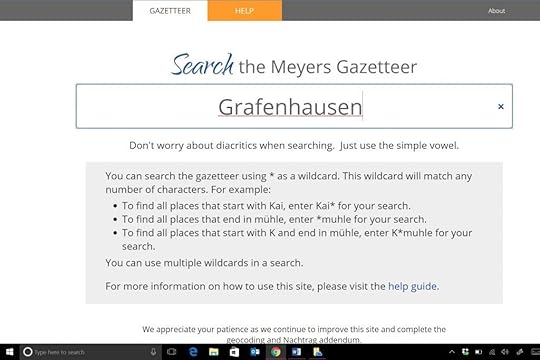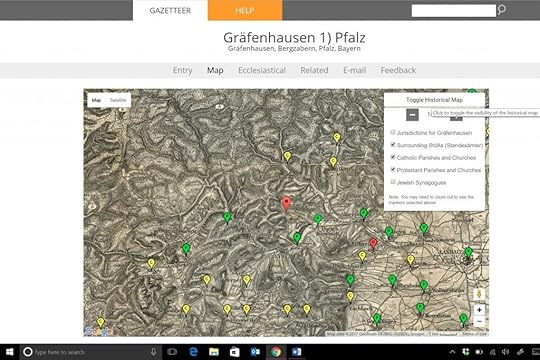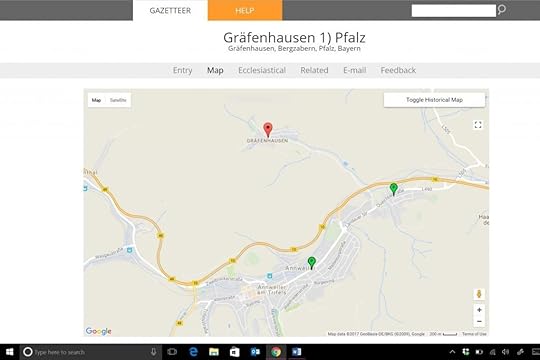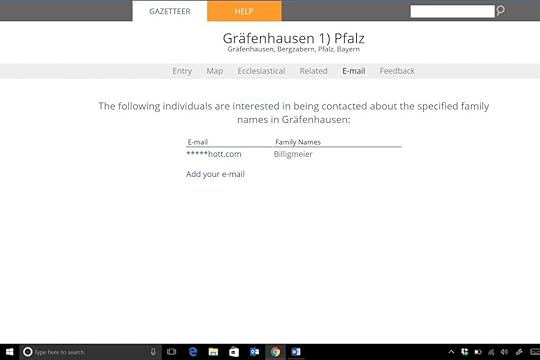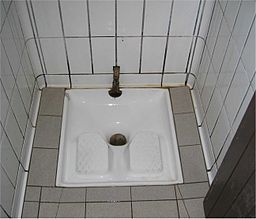Carolyn Schott's Blog, page 2
February 27, 2018
Dabbling in DNA
You may have seen the Ancestry ad where a man trades in his lederhosen for a kilt after taking a DNA test that shows he is more Irish than German.
A word of warning—if you make your wardrobe choices based on a DNA test, you may want to make sure that store takes returns. And if you plan your travel to ancestral lands that way, well, let’s just say that you should buy a refundable airline ticket. DNA ethnicity estimates are just that—estimates.
But “DNA is science,” you might argue. “It has to be right.” It’s true that the actual DNA is a biological certainty, and there are ways that DNA can be used for genealogy that are scientifically accurate. But ethnicity estimates are in the educated guess category.
As a genealogy nerd, I’ve tested with or uploaded my results to six different DNA testing firms or tools. Just for fun, I’ve been dabbling with comparing these six ethnicity estimates to my actual heritage, which I can document as 100 percent ethnic German to all 32 of my 3X great-grandparents (which takes me into the 1700s), to the 28 of 64 4X great-grandparents that I’ve identified, and to my 6X great-grandparents (about 1600s) on several lines.
Out of all these tests, only one (23andme) identified a chunk of my DNA as specifically German (or at least, German/French). Most of the tests DO correctly (but vaguely) identify large chunks of my DNA as European (north, west, central). I also think the North Atlantic and Baltic categories that GEDmatch uses make sense, as I’m fairly certain a number of my lines started out in the northeastern part of Germany that borders or is now Poland.
The numbers that look stranger to me are the high percentages in Eastern Europe and the Balkans. My peeps lived in these regions, but came from Germany and intermarried with other Germans. When I first saw these large amounts, I suspected an NPE (non-paternal event, aka a biological father that doesn’t match the documented German father I have in my records). But as I learn more, I think this is just as likely (probably more likely) to be a symptom of the estimating process than an illicit affair by one of my ancestresses.
The testing process
First, the testing companies use reference populations from their databases to estimate ethnicities. The people used for these reference populations are chosen because they appear to have deep roots in a particular area. My results are influenced by who has tested with any particular company and who the company has chosen to use as their reference population.
As far as I know, I’m not a reference population person. But if I were, I have many generations of ancestors born in Poland and Ukraine. Anyone in the reference population who looks like me would indeed appear to be Eastern European, despite the original German roots, which influences how the results for others is predicted.
You also have to look at each testing company’s definition of their geographic areas. Ancestry shows me as 6 percent British, but their definition of Great Britain includes part of the European mainland, right around France/Netherlands/Germany where my ancestors could have been roaming around.
My specific heritage also highlights the issue of migrations, and how difficult it is to pinpoint where a person came from, especially within a geographically contiguous area like Europe. (And don’t fool yourself, despite the lack of cars/trains/planes, our ancestors wandered around a lot—just more slowly.)
My heritage is German, despite the generations my family spent in Ukraine, Poland, and Hungary. And although I consider myself German, I have no idea where my family members were in the 1200s. Maybe they were in Great Britain getting ready to migrate to Germany, or part of Genghis Khan’s raiding parties heading west toward Germany. Prior to the 1600s, my ancestors might well have been somewhere other than Germany.
How to use DNA to sort this out
Bottom line—the ethnicity estimates are a lot of fun. They’re a great first step into exploring your genetic genealogy. But don’t expect this to provide significant clues to your family history.
Where DNA is helpful is by using it to identify distant cousins with whom you share DNA, and comparing your documented family history to theirs to find out new clues about your ancestors. You may discover some 3X great-grandparents that you can’t find documentation on, but your distant cousin has. You may discover that branches of your family wandered places that you never knew about. (I suspect some branches of my family ended up in Siberia or Kazakhstan, and I don’t have documentation on that.)
Best way to get started is: 1) Take a DNA test, 2) Load it to GEDmatch, 3) Buy Blaine Bettinger’s book, “The Family Tree to DNA Testing and Genetic Genealogy.” (I took a DNA workshop from Blaine once. He is awesome in his knowledge, which is the reason for the free advertising here.) GEDmatch has tons of free tools to analyze your DNA, and Blaine’s book will tell you how to make use of those tools most effectively.
Then—go forth and use real science to uncover the power of DNA.

October 22, 2017
10 Tips for Finding Your Ancestor’s Town
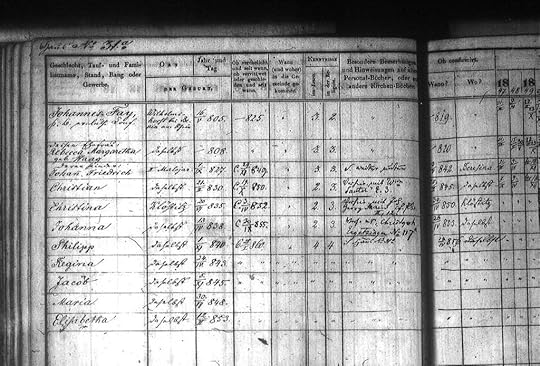
This church family record from the German village of Kloestitz in Bessarabia shows Johannes Fay’s birthplace as Wilhelmsdorf bei Benin on the Rhein.
I admire my ancestors’ sense of adventure and determination to seek out better lives by migrating from Germany to Ukraine/Poland/Hungary to North America.
But I curse that same sense of adventure, because whenever they moved, they often left their past lives behind so completely that I can’t figure out where they came from.
Since most of us have had this problem with at least one ancestor, here are some hints for finding those hard-to-find ancestral towns.
1) Church/civil records
The first most obvious place to confirm a birth location is in local civil or church records, such as birth certificates or baptismal records. Of course, knowing which town’s records to search can be a problem if you really have no idea where your ancestor is from. However, in many of the German villages where my ancestors lived the churches maintained records of each family in the town that compiled data about each family member—including birth location even if it was in a different village. Becoming familiar with all the available existing records in the places where you know your ancestors lived can unlock important clues.
2) Death records
This includes a wide range of possibilities such as church burial records, death certificates, obituaries, and death notices in newspapers. These can be a gold mine of information, with one caveat—the person most familiar with their birth location is the dead person. So they (obviously) weren’t the ones to supply the information that is recorded. Their spouse or children did, and they may or may not know accurate information or how to correctly spell the town name. Still, this has been one of my main sources for finding my ancestors’ birthplaces.

In this index of church records, the birthplace of my direct ancestor (August) shows as Prussia (very vague). But his brother Karl’s entry shows the more exact location of Plotzk, Poland.
3) Siblings and neighbors
Some of my ancestors hid their place of origin so well that I suspect they were early adopters of identity theft prevention techniques. If that’s true for you, try widening your search by looking for information on siblings and cousins and any other known relatives. By finding where they were from, you have a clear pointer where to look for your direct ancestor. This can also work if your family has close ties with another family (neighbors, frequent intermarriages, frequently serving as godparents, etc.) and if you can find that family’s place of origin. Word of caution though—even if you locate your direct ancestor’s sibling’s birthplace, you can’t automatically assume your ancestor was born there, too. It’s a clue, but you should still verify with primary sources.
4) Family papers or stories
Sometimes informal information—letters, diaries, word-of-mouth family stories—will give you a clue on where to look. If you don’t have these types of documents in your family, reach out to distant cousins to see what they have. I’ve never been able to find a primary source for the birth of my 2X great-grandmother, Katharina Bohlaender. But based on a letter written by one of her grandsons, which I received from a third cousin, I’m confident that I have her attached to the correct parents, Philipp Jakob and Eva Elisabetha (Koenig) Bohlaender. The letter described in detail each of her siblings (who I can verify with primary sources) and their spouses, as well as the occupation of her father and grandfather.

This local newspaper from Kulm, North Dakota, shows the place of birth.
5) Local history books and newspapers
Local history books at the town or church or county level are often written for celebrations, such as anniversaries of the church/town/county. Oftentimes, these books publish individual family histories that include birth locations. And if your ancestor did something to gain prominence in their community (either good or bad…having a black sheep in the family can be a plus!), there might be an article in a local paper with biographical information that will help you pin down your family’s place of origin.
6) Passenger lists
The ship’s passenger list for your ancestor might provide valuable clues. Although these often just include high-level descriptions of your ancestor’s last residence (“Germany” or “Norway”), you might hit it lucky and find a more specific location. But even if you don’t, you still may find something useful. Look at who is shown next to your ancestor on the list as they may have been traveling together. Finding that person’s place of origin might lead to your ancestor’s. Look at who your ancestor listed as their contact at their destination. That’s likely to be a family member or neighbor from their place of origin.
7) Naturalization papers
When declaring their intent to become a citizen, your ancestor had to list their place of origin. If they were detail-oriented enough to list the town and not just the country, this can give you the information you need.
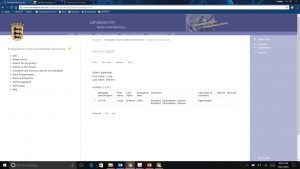
This emigration index helped me find the exact town where my ancestor, Lucas Brenner, came from when all I knew was that he was from Wuerttemberg.
8) Emigration indexes
Although not available from every district or province, some governments required their citizens to get permission to leave. While that seems terribly authoritarian to me these days, I am ever so grateful that it occurred and that records were kept. This has been invaluable for finding the specific towns some of my ancestors were from when I only had a general idea of the region.
9) Military records
In the U.S., men ages 18 to 45 were required to register for the WWI draft in 1917 and 1918. Even if you know your ancestor didn’t serve, they would still have been included in this registration. Although these don’t show your ancestor’s actual birthplace, it does show where they were living at the time of registration. Their naturalization status also provides a clue about whether they were born in the U.S. or in another country. I would never have thought about military records as a place to find a place of origin, but it’s one more possibility in searching for an ancestral town.
10) Census records
I list census records last as I’ve never seen them include anything other than very high-level information (“Russia” or “Poland”). Still, you might get lucky and it’s wise to leave no stone unturned.
I hope this sparked some new ideas of places to look for your ancestor’s place of origin. Happy hunting!

October 1, 2017
Fremont Eatery Walkabout 2017
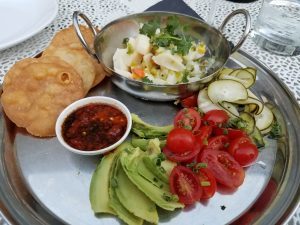 I feel like I’m on vacation every day. My Seattle neighborhood of Fremont has dozens and dozens of great places to eat within easy walking distance. When I travel, of course, I’m wandering around looking for fun places to eat, and in Fremont, I can do the same. Because restaurants come and go, I occasionally set a goal for myself of checking out each and every one. It’s a sacrifice, but I’m willing to make it.
I feel like I’m on vacation every day. My Seattle neighborhood of Fremont has dozens and dozens of great places to eat within easy walking distance. When I travel, of course, I’m wandering around looking for fun places to eat, and in Fremont, I can do the same. Because restaurants come and go, I occasionally set a goal for myself of checking out each and every one. It’s a sacrifice, but I’m willing to make it.
I’m still working my way through the list, but here are my updates for 2017:
Nice dining places
Gastropubs
Asian restaurants
Thai restaurants (there were so many, they got their own category)
Mexican restaurants
Restaurant potpourri (all the places that didn’t neatly fit in other categories)
Burgers & pizza
Sandwiches
Breakfast & dessert places (start your day here, end your day here)
Coffee places
Pubs & bars

September 6, 2017
The C in DACA stands for children
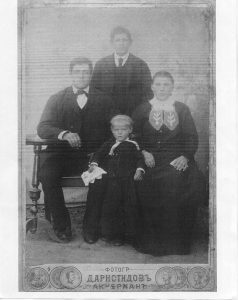 My Grandma Lydia was just 4 years old when her parents brought her to the U.S., an immigrant from what was then the Russian empire.
My Grandma Lydia was just 4 years old when her parents brought her to the U.S., an immigrant from what was then the Russian empire.
She was pretty lucky compared to today’s Dreamers. Laws about entry were a lot vaguer, no passports required. Germans from Russia were often sneered at as “Rooshians,” but she lived in an area mostly made up of fellow immigrants from Russia, so hatred and discrimination didn’t really touch her daily life.
She grew up as an American—celebrating the 4th of July in small town North Dakota, gaining an American appreciation for the importance of education for her children. She and my grandfather built up a farming business that included land in four counties and pulling a family of 12 through the Depression. She was known throughout her community for her generous spirit and inviting more people than would fit in the house over for chicken noodle soup after Sunday church services.
Her children and grandchildren and great-grandchildren include entrepreneurs and teachers and farmers and a NASA engineer and bankers and artists and accountants and medical practitioners and technology professionals and police officers. A solid contribution to the lifeblood of America.
What if?
What if at age 26 (average age of a Dreamer), she’d been forced to go back to Russia? The year was 1917, when Russia was in turmoil from revolution. Knowing no Russian, schooled in the American “work hard and you can achieve your dreams” ethic, instead she would have lived her life under the repression of Lenin and Stalin, the starvation famine of the Holodomor, and possible deportation to Siberia or Kazakhstan.
Her American dreams would be dust, her life uprooted and thrown into the chaos of an uncertain future by petty people who made the cruel decision that this generous and loving woman was somehow taking something away from them. Cruel, petty people who decided that Grandma Lydia’s ability to thrive in this land where her parents brought her was damaging America rather than building a family and farm business that contributes to its greatness.
The C in DACA stands for children, not criminals. Children innocent of any illegal acts by their parents. Children who are part of the fabric of this nation as they become entrepreneurs and teachers and medical practitioners and technology professionals.
The C in DACA stands for children, not criminals. Children should be nurtured and encouraged to achieve their dreams, not kicked aside to fend for themselves in a culture they know little about simply because of the mistakes of their parents.
The C in DACA stands for children, not criminals. Dreamers are not the criminals here. That label belongs to the cruel, petty people who would deny them their ability to go to school and earn a livelihood.
So you, too, must show love to foreigners, for you yourselves were once foreigners in the land of Egypt. (Deuteronomy 10:19, NLT)
********
A few facts in case you’re thinking “Yes, but why haven’t they become citizens?”
DACA status does not include a path to citizenship, and prior to DACA’s implementation in 2012, these children had no way to become citizens other than going back to their birth country (where they don’t know the culture and may not speak the language) and starting the bureaucratic process of applying for citizenship. This generally requires years of living outside the U.S. and expensive legal representation. Where would they live during this time? How could they afford it?
Those with DACA status are not eligible to receive most federal benefits (such as Medicaid, ACA subsidies). They are eligible to receive Social Security when they retire, but remember “the C in DACA stands for children.” None are anywhere near retirement age. They are actually benefiting Social Security currently as they pay into it via their employment.
Immigrants have been proven to boost, not drain, the economy.
(My thanks to my friend, Rusland Westerlund, whose words inspired this post: The C in DACA stands for children, not criminals.)

August 9, 2017
Fun with the Meyers Gazetteer
As children, we used to share what we did on our summer vacations. As an adult genealogist, I can’t wait to share what I learned on my summer vacation about finding ancestral towns in Germany!
The Meyers Gazetteer has gone online (not new news), but at the recent IGGP conference, I learned that it has all sorts of cool features to help you locate your town, records about the town, and other researchers.
Meyers was first published in 1912 in multi-volume book format. It’s long been the “go to” source for finding small towns in Germany as it was published before most of these small towns were swallowed up by bigger cities. In 1912, Germany was at the height of its imperial expanse, which means that it covers a large territory (and many potential ancestral towns), including areas that are no longer in Germany.
How to use Meyers online
1) Search for your town. If your town name has umlauts, use the umlauted vowel (Gräfenhausen) or no umlaut (Grafenhausen). Don’t expand the umlaut using e (Graefenhausen). If there is more than one town with your name, you’ll get a list of options choose from.
2) View the main search results. This includes a view of the original published entry in Fraktur and information about the village, with a key in the column to the right so you can decipher each description.
3) Click on the map tab. Here’s where it gets cool. The site will show you a historical map, and by hovering over “Toggle Historical Map,” you get the option to pinpoint the locations of the nearest Protestant and Catholic churches, Jewish synagogues, and Standesämter (civil offices). Click on “Toggle Historical Map” and you switch to Google maps, allowing you to locate where the town is today (even if swallowed up by a city). Clicking on the “Ecclesiastical” tab gives you a list of the specific parish names.
4) Click on the “E-mail” tab. This is cool, too. It allows you to enter your email address (masked) and the family name you are searching so you can connect with other researchers from that village!
One of the things I love about this site is that it is entirely maintained by two people who volunteer their time to make this valuable tool available for FREE for all German genealogy users. Click on the “Feedback” tab to send them a thank you!
Happy searching!

May 6, 2017
Ode to Travel Shoes
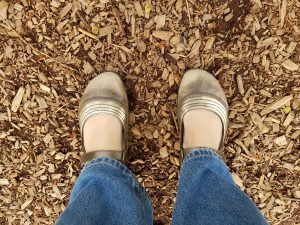
If I can travel with just two pairs of shoes on a trip that includes the theater in London, tromping through a Ukrainian cemetery on a cold spring day, and going to the beach in Abu Dhabi – then so can you!
The best shoes ever. EVER.
These little beauties draw compliments when I wear them to the office with a skirt, yet are undaunted by the ankle-twisting paths of an African village. They’re right at home at a dressy British theater, yet sturdy enough to tromp through German vineyards or pound eight miles of Dubai’s never-ending pavement.
When I showed up at a fundraising 5K event this morning, everyone else was in athletic shoes. They looked at my feet with that eyebrow-raised-is-she-nuts look. “These are absolutely my best walking shoes,” I assured more than one person who seemed genuinely concerned over my footwear.
The shoes’ distressed-metallic look is equal parts trendy and forgiving of scuffs. The angled toe makes them dressier than your standard Mary Jane, but the ankle strap gives them a nice reliable feel (no sloshing around when you walk). Stylish, arch support—what more could anyone want?
I could easily travel with these as my only shoes … except for my personal rule of always bringing two pairs. And because I often see travel packing articles that advocate being prepared for every occasion by bringing multiple pairs of shoes, I feel compelled to offer my own travel shoe advice.
Pack no more (or less) than two pairs of shoes.
More takes too much room in your luggage (“pack light” should be your mantra). Less than two leaves you without a backup plan if a strap breaks or sole cracks. (You may be thinking “Yes, but I could get them repaired where I’m visiting.” True, but will you go barefoot while you’re waiting?)
Never bring white tennis shoes (unless you’re going to a tennis camp).
Traveling in Europe helped me discover that there are actually (gasp) comfortable walking shoes that are stylish. Wearing white tennis shoes brands you as an American tourist. Make it your goal to blend in as much as you can.
Be willing to compromise on fashion.
As much as I love these shoes, they’re probably not the stylish, strappy sandals one might wear to a cocktail party. But traveling is no time for single-purpose items of apparel. If you can’t wear shoes for multiple days or events they are not worthy of a place in your suitcase. Bring those strappy sandals if your trip involves nightly cocktail parties. Otherwise, the nice looking, but not exactly Vogue-approved, pair will do. (Of course, if you’re planning a destination wedding and are bringing a pair of shoes you’ll only wear with your wedding dress, I might relax the “no single purpose shoe” rule.)

October 30, 2016
Online Security Crushes My Self-Esteem
I feel completely inadequate in my relationships whenever I’m faced with one of those online security forms asking me to answer a “secret question” to set up an online account. Their predefined set of questions mock me at every turn.
Where did you and your spouse meet? (I’m not married.)
Where was your first date with your spouse? (I told you, I don’t have one of those spouse things.)
Where did you and your spouse go on your honeymoon? (Could we move on to another topic now?)
Where was your spouse born? (So do you want me to make up a spouse? Will that satisfy you? What will it take to move on?)
And then they move on to other relationships that I don’t have.

Courtesy of Wikimedia Commons
What is your oldest sibling’s middle name? (I don’t have siblings either. Can I offer you a cousin?)
What is your oldest child’s middle name? (How many ways can you call me a failure? No, I don’t have children.)
What is your youngest child’s favorite toy? (Stop. Now.)
At the end of the interrogation by my blank-faced computer screen, I feel completely inadequate because clearly, the online world sees me as a relationship loser. But the reality is that I have a huge network of extended family and friends. In fact, it’s often hard for me to keep up with and spend time with many of my good friends (just ask them).
Dear online security people, I apologize for not fitting into your idea of what’s normal. But I wish you’d get over it and use some imagination to come up with questions that are meaningful for the many, many relationships and interests I have rather than those I don’t have. Here are some ideas.
Which of your uncles are you closest to? (Clarence)
What is the name of your oldest cousin? (DeLyle on my dad’s side, Kay on my mom’s side)
Where was your father’s father’s father born? (Freudental, Odessa oblast, Ukraine)
What was the first country you visited outside of North America? (Denmark)
Where is the most unusual place you’ve spent the 4th of July? (Probably the Greek island of Hydra, with sparklers in our watermelons)
Okay, I know these don’t apply to everyone. But clearly, neither do the spouse/children/sibling questions so why not diversify a little? Just to help a traveling genealogist maintain a little self-esteem?

October 24, 2016
Adventures of an Election Observer

Our observer team divides up precincts and makes plans
My reason for being in Ukraine became abundantly clear in a rundown bar on a Sunday morning in Odessa.
I was serving as an international observer at Ukraine’s first parliamentary election after the Maidan Revolution had toppled the corrupt, Putin-puppet president eight months earlier. My observation partner, Kevin, and I had started the day early, watching one voting station open up and two more since then, validating the openness of the physical set-up and adherence to election procedures.
Our team leader had suggested that after every few polling places we visited, we should find a coffee shop and wifi so we could upload our observation results. No doubt that worked well for him in the heart of the city, but the precinct Kevin and I had drawn was on the outskirts, far distant from any cozy coffee shops with amenities like wifi.
The ‘burbs of Odessa
To be honest, I liked that better than being in the heart of the city. Although I’m an urban gal at heart and love the beauty of Odessa and Kyiv, my peeps (ancestors) in Ukraine had lived in small villages. Those small villages are where I’d grown to love Ukraine and Ukrainians. So when we scoped out polling stations on Saturday, the day before the election, it seemed natural to me to be walking down dirt roads and broken concrete pathways as we went from school to school hosting voting stations.
It just seemed quaint that, in our fruitless search for a coffee shop with wifi, all we could find was a small outdoor market, and that when we tried to find our way back to the main street, we had to weave our way past the Azerbaijani man carrying a side of beef over his shoulder.
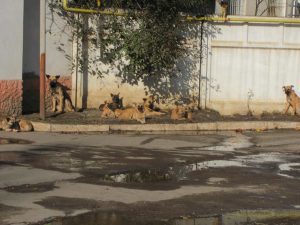
They didn’t look hungry, so….
It was a little bit less quaint when we had to walk past the pack of (wild?) dogs on the street. Kevin (who lived in Odessa and would presumably be aware that wild dogs on the street were a possibility) said, “Oh yeah, I meant to bring something in case this happened.” Clearly, I was the Girl Scout (always prepared) of our team. But, having come from Seattle where wild packs of dogs are not an everyday occurrence, I wasn’t prepared for this one. Fortunately, we were able to edge by them.
I was better prepared with basic sustenance (energy bars) because I didn’t think we were likely to find anywhere for lunch in such a rural setting. But on both the preparation day (Saturday) and the actual election day (Sunday), we encountered small neighborhood restaurants just when we needed them most. Mmm, hot borshch on a cold, fall day.
Memorable moments
But from my whole election observation experience, three memories stay with me vividly, even today, almost exactly two years later.

The ballot count begins
Counting votes
We allowed ourselves to be locked into the voting station of our choice when the doors closed at 8 p.m. for the count. I watched the transparent ballot boxes turned upside down on a big table, creating an enormous pile of ballots to be counted before any of us could leave. I watched the local election committee members manually tear corners off unused ballots and bundle them up in now-useless candidate posters. That prepared them for official disposal that would prevent the ballot boxes from being stuffed with illegally marked ballots.
One of the local observers asked me, “Is your election process in the U.S. pretty much the same?” My mind flashed to computerized voting machines, voting by mail, and being able to verify online when my ballot is received and counted, but I answered simply, “Well, it’s a little different.”
I was there as an impartial observer and took that seriously. I was there to observe whether anyone in the room was nefarious enough to cheat during the ballot counting. But when you’re locked up in a room with these people for so many hours (I think we finalized the count about 2:30 or 3:00 a.m.), you can’t help but exchange friendly conversation with everyone locked in with you—the local election committee, other observers, and … well, not the Russian TV guy. No one got friendly with him.
But the best moment was explaining (as well as I could with my 10 words of Russian) that Odessa had a special place in my heart because my grandparents (my babushka and dadushka) had been born in the Odessa oblast. I immediately became a favorite, and one of the election committee members checked in with me to throughout the evening, patting my hand and rattling something at me in Russian that was clearly fondness, apparently uncaring that I couldn’t understand a word.
I belonged. It was nice.
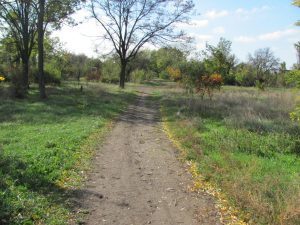
We were on the outskirts of the city of Odessa, the far outskirts.
Angry Russian
Another vivid memory is the angry Russian man. One of the polling places we scoped out the day before the election was a business office. It was hard to find the entrance and we were delighted when we found signs posted to help voters (and us) find it. We dutifully took photos to document this as a positive for this voting station.
Our picture taking apparently angered a local man, who came up and started yelling at us in Russian. Kevin explained (in Russian) that we were official, that what we were doing was okay, and showed our observer badges. The angry man turned to me and started yelling in my face instead.
It’s such a strange thing to be yelled at in a foreign language. There was nothing I can say to defuse the situation (because I didn’t know what he was angry about and he wouldn’t understand my words anyway). I just let him talk and didn’t worry until I heard the proud phrase “Я русский” (I am Russian) and then a reference to “titushky” (hired thugs who beat up pro-Ukrainians during the Maidan Revolution).
When you’re a foreigner monitoring an election that came about to a large extent because Ukrainians resisted Russia’s influence on their country, someone who is proud to be Russian and familiar with street violence is not someone you want to argue with. I looked at Kevin; he looked at me; both of us trying to decide what to do next.
At that moment, a Ukrainian woman came up, assessed the situation, and started scolding the man, waving her finger in his face. When clearly he was not going to give up and leave us alone, she smiled ruefully at us, grabbed him by the coat sleeve and dragged him off with her down the road.
Don’t mess with Ukrainian women.

A well-organized voting station, with curtained voting booths and ballot boxes readily visible to prevent mischief.
Sunday morning in a rundown bar
But coming back to the rundown bar on election morning where we had the most memorable conversations of the day. It was a drab little place that mostly served alcohol though I managed to get a cup of coffee. No one there had ever thought to need wifi.
A drab little place with people who had nowhere better to be on that Sunday morning than in a bar, drinking. It seems an unlikely spot to be memorable. But the people in the bar showed me just what Ukraine was fighting for.
When we explained why we were there (we felt some explanation was necessary as I doubt another American had ever wandered into this place), the bartender broke into a big smile, and she said, “Thank you for what you are doing for Ukraine!” She talked enthusiastically about how Ukraine needed to change and the hope that Maidan had brought to the country.
One of the patrons of the bar was equally animated, but less optimistic. To make his Russian understandable, he illustrated what he was saying with his hands, making broad gestures to represent average people being crushed by the oligarchs in power. He talked bitterly of how nothing had changed, nothing would change.

Me, Kevin, and a party observer during the long evening of counting ballots.
Hope for a brighter future.
Despair that any change was possible.
I realized right then, that’s why I was there—to contribute in some small way to banishing the despair and fanning the flame of hope.
Two years later, I could walk into that same bar and probably have the same conversation. Some people would have hope and recognize that some positive changes have happened. Some would feel despair at the glacial pace of the change, that the system is too broken to be fixed quickly or at all.
Ukraine has a long way to go. Hope and despair. Which will win out?

September 15, 2016
Welcome Back to Osthofen
From the very first email, I felt my ancestral town of Osthofen reaching out to welcome me. The email was, of course, not from the town itself but from my guide for the day, Ursula Feile from the tourist office. Her cheery note: “We’re so excited you’re visiting the town of your ancestors. We’ll show you around and drink wine,” immediately drew me in.
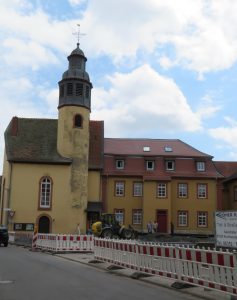
The “little” (former Lutheran) church
The little church
When I arrived in Osthofen, she greeted me with “I have something special planned.” Our first stop was a small coffee shop—which also happened to be my ancestors’ church. In the 1700s and early 1800s, Osthofen had two churches. The large, impressive, stained-glass-windows and frescos-on-the-wall church on the hill overlooking the town was the home of the larger Reform congregation. The Lutheran church (where my Schott family attended) was smaller and plainer, dark wood and white walls, occupying a street corner in the center of town.
Today, the “little church” has been renovated. The top floor is used for worship services in winter, while the ground floor serves as a coffee shop that sells fair trade goods to raise money for projects to alleviate poverty in Africa. I felt so proud. Not only is my ancestors’ church still in use, but it practices the social mission of the Church by following Jesus’ command to love your neighbor wherever they are. Wow.
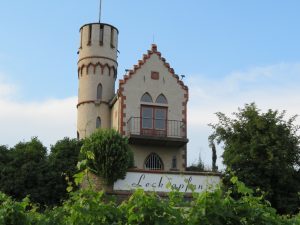
Vineyard outside Osthofen
It’s all about the wine
Wine is an important part of Osthofen’s culture—the town is surrounded by vineyards. So the natural next event was hiking through the vineyards, or the Weinberge. I understood Ursula’s concern that I wear good shoes for our walk, but it was a bit of a surprise to find that we were actually hiking to the next village. I thought the discussion of nearby Mühlheim was about history, not destination. (Clearly, I need to work on my German language skills.) But the short hike provided beautiful views and a visit to a centuries-old mill, now the home of one of Ursula’s friends.
Ursula had gathered a group of local guides for dinner, all passionate about local history and interested in my journey to seek out my ancestors. They told me about the history of the town; I told them about the Schott family’s adventures traveling to Galicia (now western Ukraine) and the Black Sea area after they’d left Osthofen. The restaurant was beautiful with an interesting upscale menu, but was located in a former stable with a soaring stone-vaulted ceiling.
After dinner, we stopped at a small wine garden, open only a couple of nights per week. It looked more like a big family party than a public place. I would have felt like I was intruding if I’d walked in on my own. But the owners loved my story about seeking out my roots and poured me some wine.
Peering into the 18th century
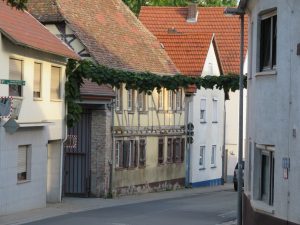
Wandering through Osthofen
A visit to the big, ornate church on the hill and a personalized tour of the local Heimatmuseum the next morning helped me learn more about how people had lived in Osthofen for centuries. But simply walking through the town with Ursula was almost more special.
She had a gift for relating what we saw to my ancestors’ time. She helped me see beyond the modern façade to see the lines of a small typical home in the 18th century. Her descriptions brought blocks of stone and wire fencing along a creek-side walkway to life with scenes of the village women gathering to do their wash and share the daily news.
Finding Susanna
As a genealogist, the most special moment was a trip to the cemetery. I’ve wandered many cemeteries in search of my ancestors’ final resting places. For my grandparents and a couple of great-grandparents in the Dakotas, this was a simple search. But cemeteries in Germany, Ukraine, Hungary have been a disappointment. German cemeteries in Ukraine and Hungary have mostly been destroyed. Cemeteries in Germany recycle their graves, and you rarely find any older than 35 years.
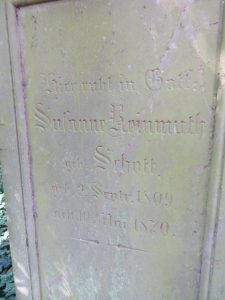
My cousin, Susanna Schott Reinmuth b. 1809 d. 1870
When Ursula said she had a Schott grave to show me, I didn’t hold out much hope. There was another Schott family in Osthofen, larger than mine and connected to the larger Reform congregation. Any Schott graves were likely to belong to them. When she pointed out the partially overgrown stone of Susanna Schott, born 1809—the year my 3x great-grandparents, Philipp Jakob and Maria Dorothea (Finger) Schott left Osthofen—I dutifully took a photo, but without much enthusiasm.
But when I compared the photo to my family tree, I discovered that Susanna is related to me not once, but twice! She’s my first cousin four times removed because her grandparents, Johann Jacob and Anna Margaretha (Lacker) Finger, are my 4x great-grandparents. She’s also my second cousin four times removed because her great-grandparents, Michael and Maria Elisabetha (Reichert) Schott, are my 5x great grandparents.
There is still a little part of me, a little trace of my family history, in Osthofen after all.
Captivated by Osthofen
Osthofen is a modern German town, a bedroom community of Worms with an industrial area on the edge of town that no doubt provides employment for much of the population. Its surrounding vineyards give it a pleasant setting, but it doesn’t have the storybook, postcard-perfect charm of many German villages I’ve seen.
But on this visit, Osthofen captivated me. Unlike previous visits, in which I’d wandered the streets on my own hoping to feel the lingering presence of family ghosts, this time I felt the warmth of the town reach out to me. I could picture Maria Dorothea, and her mother Anna Margaretha before her, gathered at the river washing clothes. I could imagine them leaving their small house and walking to the church for worship each Sunday.
I felt the camaraderie with my new-found friends as local wine fueled an animated discussion of the town’s heritage. And in finding Susanna’s grave, I found that a little piece of my family remains anchored to the town, despite the wandering of Philipp Jakob and Maria Dorothea as they migrated eastward.
My feet have walked in the path of generations of Schotts and Fingers, and I have been welcomed back after centuries of family wandering. It felt good to be welcomed home.
*****
Photos of Osthofen: the little (Lutheran) church, the Reform church on the hill, wandering the vineyards, fun times with new friends, various views of Osthofen

August 11, 2016
The Art of the Squatty Potty
The nice porcelain version Source: By Mintguy [GFDL (http://www.gnu.org/copyleft/fdl.html) or CC-BY-SA-3.0 (http://creativecommons.org/licenses/b...)], via Wikimedia Commons
In travel, not all toilets are created equal. Some are much less equal than others.Of course, I am referring to the squat toilets found in many parts of the world outside of North America. Some can be gleaming porcelain fixtures, while others are nasty holes in the ground (and lots of variations in between).
When I lived in Greece 20 years ago, I got used to the gleaming porcelain versions. So much so, I couldn’t figure out why visiting friends were so appalled when we found these in roadside restrooms. After all, I figured they were reasonably hygienic as nothing but the bottoms of your shoes touched anything.
Still, using them takes a bit of skill. So here are my eight tips for using a squat toilet. (Men, read no further. These don’t apply to you and you are not allowed to complain about primitive bathroom facilities as your anatomy makes them much less problematic.)
![A more primitive version By SuSanA Secretariat [CC BY 2.0 (http://creativecommons.org/licenses/by/2.0)], via Wikimedia Commons](https://i.gr-assets.com/images/S/compressed.photo.goodreads.com/hostedimages/1471123845i/20004299.jpg)
A more primitive version
By SuSanA Secretariat [CC BY 2.0 (http://creativecommons.org/licenses/b...)], via Wikimedia Commons
Grab a handful of toilet paper before squatting. There’s nothing more awkward than squatting with thighs burning and trembling, trying not to drip, and grappling to unroll toilet paper. (If it’s a squat toilet, there may not be toilet paper available so it’s good to carry a supply of your own.)
To avoid splashing, squat down as low as your thighs will take you (see tip 1). Liquid will accelerate if it travels a greater distance, making it much more likely to splash high (and all over you) if your aim isn’t perfect.
Another tip to avoid splashing is to release slowly. I know you’re anxious to get out of there and want to pee quickly and escape. But if you let loose everything at once, it tends to spatter. Again, all over you. Nasty.
Releasing slowly also allows you to adjust your aim if necessary. You may need to position yourself a little farther back from the hole than you’d expect. If your aim isn’t perfect and you’re gushing, well, again, we have the splash problem. Nice to give yourself the opportunity to adjust your aim as necessary.
Apply toilet paper while squatting (to avoid dripping), then toss the toilet paper down the hole or in the trash can provided (whatever they request). This leaves your hands free, which will be useful in tip 7.
If you haven’t followed tip 1, you might feel stuck in the squat position at this point (thighs quivering). You’re frantic to get up without touching anything. Use your hands to push against the tops of your own feet (which you’re likely to be willing to touch) to leverage yourself out of the squat position.
Hand sanitizer is your friend.
See, not so hard, is it? I dare you to go out and practice!



